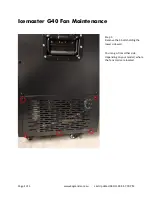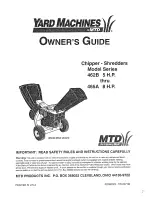
55
BXTR6438
Problem
Cause
Solution
Noisy drive belt, premature
wear.
Drive belts loose or worn.
Inspect drive belts. Adjust tension or replace if needed. See
Wrong replacement belt.
Inspect drive belts. Replace. See
Sheaves misaligned.
Check sheave alignment and adjust. See
.
Rotor plugged.
Inspect and clear chipper hopper, lower rotor housing, and rotor.
Belt tension too high.
Check belt tension and adjust.
Sheaves worn.
Inspect sheaves and bearings. Replace if required.
Oil or grease on drive system.
Check source of oil or grease and correct. Clean sheaves and belts. Belts
may require replacement.
Rotor bearings.
Check and replace if required.
Poor Chip Quality.
Dull blades.
Check rotor and ledger blades. Rotate, sharpen, or replace. See
.
Drive belts loose or worn.
Inspect drive belts. Adjust or replace if needed. See
Poor quality material.
Material is small or rotting. Mix with higher quality material.
Knife clearance incorrect.
Check and adjust as required. See
Feed rollers intermittent or
not turning
Feed roll control bar set to stop.
Move to Forward or Reverse position.
Engine speed not at or above minimum setting.
Set engine throttle for maximum rpm. Make sure engine is properly
tuned. Adjust P3 programming. See
.
P3 programming incorrect.
Check that P3 settings are at factory specifications. Reset if required.
P3 not receiving signal.
Inspect rotor sensor for damage. Replace unit if required.
Inspect rotor sensor mount or sheave mounted indicator plate for
damage or misalignment. Repair or replace.
Check P3 controller for output signal. Replace unit if required.
Check harness for bad ground connection.
Inspect wiring harness for damage. Repair or replace if damaged.
P3 hydraulic control valve malfunction.
Inspect hydraulic control valve for damage. Check functionality.
Feed control bar malfunction.
Check feed control bar switches. Replace, reposition pickup trigger.
Slow hydraulic flow.
Filter is dirty. Change filter.
Hydraulic oil is contaminated. Inspect oil condition for dirt, foaming.
Replace oil.
No electrical power.
Check battery, engine charging system for power.
Hydraulic motor slow.
Check hydraulic circuit, oil, and motor condition. Replace if required.
Roller drive key sheared.
Check and replace.
Hydraulic pump fault.
Repair or replace.
Hydraulic oil overheating.
Noisy hydraulic pump.
Reservoir oil level is too low.
Fill reservoir until fluid is visible in sight glass.
Dirty filter.
Change filter.
Hydraulic oil contaminated.
Inspect oil condition. Check for dirt or foaming.
Replace oil.
Feed rollers binding.
Inspect bearings. Lubricate or replace.
Lines crimped or pinched.
Inspect, repair, or replace lines.
Worn pump.
Check and replace.
Line leak.
Inspect hydraulic lines and connections for leaks. Repair or replace.
Pump leak.
Pump seals are worn. Replace.
Pump noisy at startup.
Oil temperature too low. Allow machine to warm up before putting to
work.











































